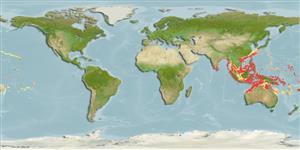Common names from other countries
>
Carangiformes (Jacks) >
Carangidae (Jacks and pompanos) > Caranginae
Etymology: Selar: A Malay vernacular name, ikan selar.
More on author: Cuvier.
Environment: milieu / climate zone / depth range / distribution range
Écologie
marin récifal; profondeur 35 - 500 m (Ref. 4233). Subtropical; 31°N - 23°S, 75°E - 134°W
Pacific Ocean: Andaman Islands to Vanuatu, north to the Philippines, south to northern Australia.
Taille / Poids / Âge
Maturity: Lm ? range ? - ? cm
Max length : 25.0 cm FL mâle / non sexé; (Ref. 4233); common length : 22.0 cm FL mâle / non sexé; (Ref. 4233)
Épines dorsales (Total) : 9; Rayons mous dorsaux (Total) : 23 - 25; Épines anales: 3; Rayons mous anaux: 19 - 21.
Adults are found inshore and form large schools on day time. They disperse at night to feed on planktonic and benthic invertebrates such as crabs and shrimps. Eggs are pelagic (Ref. 4233, 7300, 90102).
Life cycle and mating behavior
Maturities | Reproduction | Spawnings | Egg(s) | Fecundities | Larves
Paxton, J.R., D.F. Hoese, G.R. Allen and J.E. Hanley, 1989. Pisces. Petromyzontidae to Carangidae. Zoological Catalogue of Australia, Vol. 7. Australian Government Publishing Service, Canberra, 665 p. (Ref. 7300)
Statut dans la liste rouge de l'IUCN (Ref. 130435)
CITES (Ref. 128078)
Not Evaluated
Menace pour l'homme
Harmless
Utilisations par l'homme
Pêcheries: commercial
Outils
Articles particuliers
Télécharger en XML
Sources Internet
Estimates based on models
Preferred temperature (Ref.
115969): 13.4 - 26.5, mean 20.4 (based on 400 cells).
Phylogenetic diversity index (Ref.
82804): PD
50 = 0.7500 [Uniqueness, from 0.5 = low to 2.0 = high].
Bayesian length-weight: a=0.01622 (0.00952 - 0.02762), b=3.02 (2.88 - 3.16), in cm Total Length, based on LWR estimates for this species & (Sub)family-body (Ref.
93245).
Niveau trophique (Ref.
69278): 3.5 ±0.41 se; based on food items.
Résilience (Ref.
120179): Haut, temps minimum de doublement de population inférieur à 15 mois (K=1.90).
Fishing Vulnerability (Ref.
59153): Low vulnerability (18 of 100).
